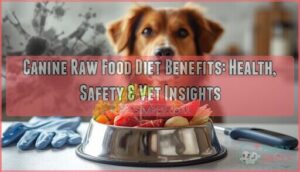This site is supported by our readers. We may earn a commission, at no cost to you, if you purchase through links.
Raw meat sits in your dog’s bowl, and you wonder if you’re making the right call. The canine raw food diet benefits debate divides pet owners and veterinarians alike, yet the nutritional science tells a compelling story.
Raw feeding delivers concentrated protein with intact amino acids, naturally low carbohydrate levels that mirror ancestral eating patterns, and enzymes that survive the journey to your dog’s gut. The payoff shows up in shinier coats, firmer stools, and leaner body composition.
But pathogens like Salmonella lurk in improperly handled raw meat, and homemade recipes often fall short on calcium or essential vitamins. Understanding both the advantages and the risks helps you decide whether raw feeding fits your dog’s needs and your lifestyle.
Table Of Contents
- Key Takeaways
- Key Nutritional Benefits of Raw Diets
- Improved Digestive and Immune Health
- Skin, Coat, and Dental Advantages
- Increased Energy and Overall Wellness
- Considerations and Safety of Raw Feeding
- Frequently Asked Questions (FAQs)
- What are the benefits of feeding your dog a raw food diet?
- Are dogs on a raw diet healthier?
- Do vets recommend a raw diet for dogs?
- What is the disadvantage of raw dog food?
- What risks does raw food pose?
- How do I know if my dog is allergic?
- Can puppies eat raw food?
- What are the long-term effects?
- How much does raw food cost?
- How do raw diets affect dog behavior?
- Conclusion
Key Takeaways
- Raw diets offer higher protein, improved nutrient absorption, and lower carbohydrates than kibble, supporting lean body mass and digestive health.
- Dogs fed raw food often show shinier coats, firmer stools, reduced shedding, and better dental hygiene due to preserved enzymes and bioavailable nutrients.
- Risks include pathogen exposure, nutritional imbalances, and increased antibiotic resistance, making strict food safety and professional oversight essential.
- Most veterinarians urge caution with raw feeding, recommending evidence-based formulations and regular monitoring to minimize health hazards.
Key Nutritional Benefits of Raw Diets
Raw diets center on feeding your dog what their ancestors thrived on: unprocessed meat, bones, organs, and limited plant matter. This approach fundamentally changes how nutrients enter your dog’s system compared to highly processed kibble.
Let’s look at the core nutritional advantages that make raw feeding distinct from conventional dog food.
High-Quality Protein and Essential Fats
Raw diets deliver concentrated protein sources, with beef averaging 20.9% and duck reaching 53%, providing amino acids that a dog’s body can actually use. These diets also offer a range of fat content, from 10.5% in chicken to 22% in duck formulas, which fuels energy metabolism through efficient fat digestibility at 97.5%.
The omega-rich ingredients in raw diets support various aspects of a dog’s health, from coat shine to cellular function. However, it’s essential to maintain omega ratios between 5:1 and 10:1 for optimal animal health.
A balanced raw diet requires high-quality protein sources to ensure prime canine health.
Greater Nutrient Bioavailability
Those concentrated proteins mean little if your dog can’t absorb them properly. That’s where raw diets truly shine—nutrients from whole foods show higher bioavailability than synthetic additives in kibble. Dogs on raw food demonstrate increased serum micronutrients, suggesting their bodies actually use what they’re eating. Raw diets also promote a more diverse gut microbiome compared to kibble.
Why raw diets deliver better nutritional value:
- Natural enzyme activity enhances protein and fat breakdown
- Phytonutrient retention maintains antioxidant benefits
- Whole-food mineral absorption outperforms isolated supplements
- Vitamin integrity stays intact without high-heat processing
Low Carbohydrate Content
Beyond bioavailability, raw diets naturally deliver just 5–10% carbohydrates versus kibble’s 30–60%. This matters for glucose response and insulin sensitivity in your dog. Studies show raw-fed dogs maintain lower blood sugar levels and better activity levels than kibble-fed counterparts. That carbohydrate reduction directly lowers obesity risk, with less than 10% carbs supporting healthier weight outcomes and lean body mass.
| Diet Type | Carbohydrate Content |
|---|---|
| Raw diets | 5–10% |
| Many raw formulations | Near 0% |
| Commercial kibble | 30–60% |
| Extruded dry foods | Often >40% |
| Ultra-low carb formulas | ~1% metabolizable energy |
Inclusion of Natural Enzymes and Micronutrients
Cooking destroys enzymes above 118°F, but raw diets preserve these digestive helpers intact. Your dog’s gut benefits immediately—low molecular weight peptides increase by 48.7% within 30 minutes, boosting nutrient absorption.
Enzyme supplementation in raw food raises dry matter digestibility by 18.7% and energy by 18.1%. Heme iron bioavailability reaches 90% in raw diets versus just 2–20% from plant sources, optimizing micronutrient sources for canine nutrition.
Improved Digestive and Immune Health
When you switch your dog to a raw diet, one of the first changes you’ll notice happens in the gut. Better digestion doesn’t just mean less mess in the yard—it can influence everything from nutrient uptake to how well your dog’s immune system functions.
Let’s look at how raw feeding aids digestive and immune health in measurable ways.
Enhanced Digestibility and Nutrient Absorption
Think of your dog’s digestive system as a highly efficient nutrient extraction plant—raw diets can optimize its performance. Studies show dogs on raw diets achieve digestibility rates exceeding 95%, compared to just 57% on kibble, with protein absorption and raw bioavailability considerably higher.
Raw diets transform your dog’s digestion, delivering over 95% nutrient absorption compared to just 57% from kibble
This enhanced efficiency stems from enzyme activity and minimal processing, supporting your dog’s digestive health and gut microbiome. Fecal biomarkers confirm improved gut barrier function, especially after sustained diet duration on raw feeding.
Firmer Stools and Less Odor
When your dog transitions to a raw diet, you’ll likely notice smaller, firmer stools with considerably less odor—a clear sign of improved digestive health. Higher protein digestibility and appropriate diet composition reduce undigested residue reaching the colon, which limits gut bacteria putrefaction and lowers fecal dry matter moisture.
Gut microbiota changes also contribute to odor reduction by:
- Decreasing ammonia production from protein fermentation
- Reducing volatile sulfur compounds linked to malodor
- Shifting bacterial populations away from putrefactive species
- Lowering branched-chain fatty acid concentrations
- Minimizing indole and phenol formation in the large intestine
These measurable improvements in gastrointestinal health reflect your dog’s enhanced nutrient absorption and balanced gut environment.
Support for Food Sensitivities and Allergies
If your dog struggles with food allergies or digestive issues, raw diets offer hypoallergenic potential through single-protein exclusion diet benefits.
Studies show puppies fed raw organ meats and tripe experienced considerably lower allergy prevalence as adults, with over 80% achieving remission within five weeks.
Raw vs. processed comparisons reveal fewer synthetic additives and improved immune system health, supporting better food allergy management and enhanced immune function through greater nutritional impact.
Strengthened Immune System Function
Your dog’s immune system gets a clear boost from raw feeding, with research showing considerably higher fecal immunoglobulins and anti-inflammatory effects. About 70% of immune function lives in the gut, where raw diets deliver three key advantages:
- Enhanced gut enzyme production protecting intestinal barriers
- Microbiome modulation through natural probiotics and nutrients
- Micronutrient support from bioavailable selenium and zinc
These health benefits translate to stronger defenses against pathogens and reduced inflammatory markers in dog health.
Skin, Coat, and Dental Advantages
One of the most visible changes dog owners notice after switching to raw is how their dog looks and feels on the outside. Your dog’s coat, skin, and teeth often reflect what’s happening inside their body, and raw feeding can make a real difference in these areas.
Let’s look at the specific ways a raw diet encourages healthier skin, a shinier coat, and better dental hygiene.
Shinier Coats and Healthier Skin
You’ll likely notice your dog’s coat turning softer and shinier on a raw diet, and that’s no coincidence. Enhanced fatty acid intake from raw meat boosts skin health from within.
Clinical studies show raw-fed dogs scored markedly better on skin and coat evaluations (P=0.04). Owner-reported outcomes back this up—75% of surveyed owners saw visible improvements.
The health benefits stem from nutrient bioavailability and gene expression evidence supporting cellular repair and reduced inflammation.
Reduced Shedding and Skin Irritation
Beyond the shine, you’ll see a tangible dietary impact on shedding itself. Raw-fed dogs showed 50% reduced shedding compared to just 16% in kibble-fed peers.
Early exposure matters—puppies with at least 20% raw foods had up to 64% lower odds of excessive shedding as adults.
The microbiome influence, allergy reduction, and proper ingredient ratios all work together to support healthier skin and a better haircoat through improved pet health.
Cleaner Teeth and Fresher Breath
Your dog’s mouth tells its own story about diet quality. Research found a 70.6% reduction in dental calculus after just 12 days on raw food, while studies confirm considerably less plaque buildup compared to kibble.
Raw diets naturally limit carbohydrate intake, starving bacteria that cause bad breath. The enzymatic action in unprocessed meat also helps break down debris, leading to veterinary outcomes that include fresher breath and cleaner teeth.
Natural Dental Hygiene From Raw Bones
Beyond mechanical cleaning, raw bones offer your dog something closer to nature’s toothbrush. When your dog chews raw bone, the natural abrasion reduces oral bacteria by 79%—outperforming standard dental chews. This bacteria reduction directly prevents periodontal disease, with studies showing 70–87% improvement in periodontal markers within weeks.
Properly sized raw bones also strengthen gum tissue through stimulation, all while maintaining an excellent safety profile when supervised appropriately.
Increased Energy and Overall Wellness
When you switch your dog to raw food, you’ll often notice changes that go beyond what’s visible on the surface. Many owners report their dogs seem more active, maintain healthier weights more easily, and just generally feel more vibrant.
Let’s look at the specific ways raw feeding can boost your dog’s energy and overall wellness.
Higher Energy Levels and Vitality
When you switch your dog to a raw diet, you’re fundamentally changing how their body fuels itself. Raw-fed dogs exhibit markedly higher ketone levels, indicating their bodies rely more efficiently on fat for sustained energy rather than carbohydrate crashes.
This metabolic shift translates to real performance outcomes: sporting dogs on raw diets work up to 20% longer before fatigue sets in. The nutrient absorption improves dramatically, and reduced carbohydrate content means your dog maintains consistent vitality throughout the day.
Better Weight Management
That metabolic efficiency also powers sustainable weight management. Raw diets naturally support portion control through high satiety levels—your dog feels fuller longer, reducing overall caloric intake.
The high-protein, low-carb profile preserves muscle maintenance during fat loss, while improved digestibility means your dog absorbs more nutrients from less food.
Studies show dogs on raw diets lose weight consistently without regaining it, thanks to better diet compliance and maintained lean mass.
Enhanced Hydration From Raw Foods
Because raw diets deliver 70–75% moisture compared with kibble’s 5–10%, your dog absorbs considerably more water from each meal. This moisture content transforms systemic benefits, urinary health, and stool quality by increasing overall water intake while reducing voluntary drinking.
The nutritional benefits of raw food include:
- Diluted urine that lowers stone formation risk
- Softer, well-formed stools with better digestive comfort
- Enhanced hydration supporting kidney function and thermoregulation
Improved Joint and Bone Health
When your dog’s meals include raw bones and omega-3-rich proteins, you’re delivering calcium, phosphorus, and anti-inflammatory compounds that support joint inflammation reduction and bone density support.
Raw bone benefits extend beyond dental benefits—they provide bioavailable minerals that strengthen skeletal structure and may lower the risk of bone fractures and degenerative disease prevention, particularly in aging dogs on a raw diet.
Considerations and Safety of Raw Feeding
Raw feeding offers real benefits, but it’s not without risks you need to understand before making the switch.
From pathogen concerns to nutritional balance, there are practical safety considerations that can make or break your dog’s health on this diet.
Let’s walk through the key factors you should weigh carefully before filling your dog’s bowl with raw food.
Pathogen Risks and Food Safety Practices
While raw diets offer nutritional appeal, they carry real risks. Studies show nearly 25% of commercial raw dog foods harbor bacterial contamination, including Salmonella and Campylobacter, with documented zoonotic risks to family members.
E. coli resistance rates climb in raw-fed dogs, reaching 40% compared to 17% in those eating cooked food. Safe handling protocols—thorough handwashing, refrigeration, and surface disinfection—are essential protective measures you can’t afford to skip.
Balancing Home-Prepared Raw Diets
Making your own meals at home sounds simple, but up to 95% of homeprepared raw diets fall short of complete and balanced nutrition standards.
Nutrient deficiencies—especially calcium, vitamin D, and zinc—plague 80% of recipes. Without proper supplementation practices and ingredient ratios guided by veterinary nutrition experts, dietary imbalances can harm your dog.
Recipe formulation isn’t guesswork; it requires professional oversight to meet veterinary guidelines.
Suitability for Different Dog Ages and Health Status
Not every dog is a good match for raw feeding, and your pup’s age and health status matter. Puppy raw diets require strict pathogen control—80% of raw batches tested positive for Salmonella.
Senior dog health can improve with fresh foods, showing better metabolic markers. Immune status risks climb for compromised animals.
Chronic disease diets and allergy raw diets may benefit some dogs, but always consult your veterinarian first.
Veterinary Perspectives and Recommendations
What do veterinarians actually recommend when you ask about raw feeding? Veterinary medicine emphasizes raw safety through evidence-based diet formulation. Most veterinary recommendations include:
- Choosing AAFCO certification products to prevent nutritional deficiencies
- Understanding zoonotic transmission risks to your family
- Implementing strict food handling protocols
- Scheduling regular nutritional monitoring
- Discussing your dog’s individual needs with your veterinarian
Veterinary advice focuses on minimizing risks while maximizing benefits.
Frequently Asked Questions (FAQs)
What are the benefits of feeding your dog a raw food diet?
Picture the shine of a wolf’s coat in the wild—raw diets for dogs echo that Wild Ancestry, offering Diet Palatability, Allergy Relief, Enzyme Retention, and Overall Health.
With improved immunity and digestibility among key raw food advantages.
Are dogs on a raw diet healthier?
Dogs on a raw diet often show better skin, shinier coats, and firmer stools, thanks to higher digestibility and nutrient bioavailability.
Still, veterinary opinions highlight risks like pathogens and nutritional imbalances, so long-term effects require careful consideration.
Do vets recommend a raw diet for dogs?
If you stacked all the veterinary position statements end to end, you’d see a clear pattern: most veterinarians don’t recommend a raw diet for dogs, citing pathogen concerns, nutritional adequacy issues, and the gap between owner perceptions and veterinary guidelines.
What is the disadvantage of raw dog food?
Raw dog food comes with real disadvantages: Pathogen Contamination and Digestive Hazards can threaten your dog’s health, Nutritional Deficiencies are common, Financial Barriers add up, and Veterinary Concerns highlight ongoing safety issues and long-term health risks.
What risks does raw food pose?
It’s easy to think fresh means safe, but raw food can expose your dog—and your household—to pathogens like Salmonella, zoonotic risks, nutritional imbalances, and physical hazards from bones.
Food safety and suitability concerns should guide your choices.
How do I know if my dog is allergic?
You’ll notice allergy symptoms like itching, recurrent ear infections, digestive issues, or soft stools. Diagnostic methods often include elimination diets to identify food triggers. Veterinary consultation is essential for confirming food allergies and guiding safe, effective care.
Can puppies eat raw food?
Picture a playful puppy beside a bowl of raw food—tempting, yet risky. Puppy Raw Feeding demands precision, as nutritional deficiencies and poor bone development can result.
Pathogen exposure is high, so always seek veterinary guidance before choosing a raw diet for puppies.
What are the long-term effects?
Over time, dogs fed a raw diet can face increased mortality rates, skeletal issues from nutritional deficiencies, and health problems tied to pathogen shedding and antibiotic resistance.
Veterinarians stress careful planning to avoid these long-term risks and complications.
How much does raw food cost?
Monthly raw costs for dogs range from $75 to $450, depending on size, brand, and bulk buying options. Compared to kibble, raw diet expenses are higher, especially for larger breeds.
Home prep expenses vary with ingredient choice and supplements.
How do raw diets affect dog behavior?
Raw diets in dogs don’t increase overall aggression, but may boost food guarding in multi-dog homes.
You’ll often see anxiety reduction, greater playfulness, less hyperactivity, and a cognition boost—clear behavioral benefits balanced with practical risks to dog health.
Conclusion
As the saying goes, “the proof is in the pudding”—and your dog’s health is the clearest evidence of your choices. The canine raw food diet benefits are real, but they hinge on careful preparation and vigilance.
When you balance nutritional needs with safety, you give your dog a chance to thrive.
Trust your observations, consult your veterinarian, and remember: a mindful approach to feeding can transform your dog’s wellbeing, one meal at a time.
- https://pmc.ncbi.nlm.nih.gov/articles/PMC11816250/
- https://www.myollie.com/science/further-studies-proving-the-fresh-food-difference/
- https://rawfeeding101.com/blogs/dog-nutrition/impact-of-raw-feeding-on-dogs-dental-health/
- https://poppyspicnic.co.uk/blogs/raw-pet-food/the-science-behind-why-raw-food-reduces-allergies-in-dogs
- https://international-animalhealth.com/wp-content/uploads/2020/12/Nutritional-Benefits-of-Raw-and-lightly.pdf














